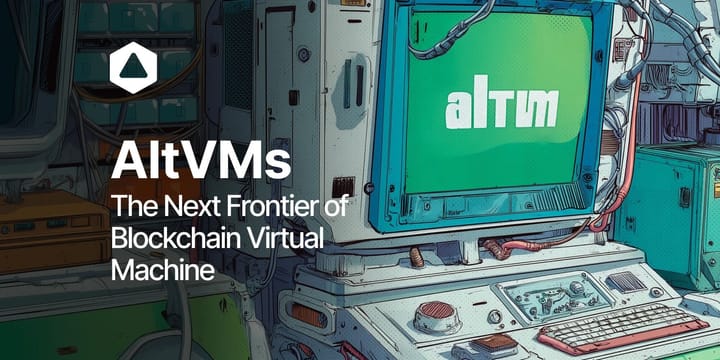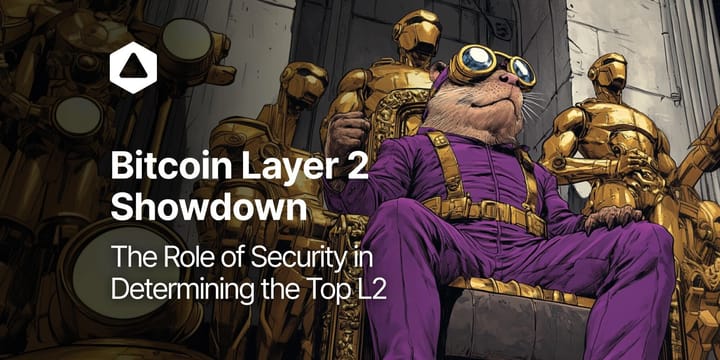What is MEV and Why Should Bitcoin Users Care?
Explore the evolving landscape of MEV in Bitcoin: from its Ethereum origins to its impact on DeFi, rollups, and network security. Learn why experts are redefining MEV and what it means for Bitcoin's future.

With Bitcoin becoming a foundational network and for some the groundwork that could offer an even bigger ‘world computer’ than Ethereum is. By bridging all things that were built throughout the years, with the courtesy of Ethereum and platforms such as Bitfinity making this possible.

But at this forefront there are things crawling that are not completely beneficial for everyone involved in the space. A surge from 'miner extractable value' that has happened on Ethereum for the last few years is now coming to Bitcoin as well.
In this article we’ll take a look at the rise of MEV and what it means on Bitcoin and how we can understand the context of this peculiar concept.
What is MEV?
To start off, what does MEV stand for? Well MEV, which is originally known as 'miner extractable value,' refers to the profits that miners or validators can earn through their ability to manipulate the order of transactions in a blockchain block.
“Some people expand this definition even further, to ANY extra revenue a miner can make, for example selling surplus heat to grow tomatoes or even a side business selling miner branded t-shirts,” according to BitMEXResearch.
Thus, MEV is a term defining the capability, which is used for better but more often for worse, that allows anyone with the backing capital and knowledge to include, exclude, or reorder transactions to their advantage.
Example of MEV
We can look at an example, where we see a user that initiates a transaction and enters with his transaction a pending state and waits for confirmation in the "mempool", the place transactions wait until its time to be added to the blockchain.

What miners or validators can do, while they are responsible for assembling these transactions into blocks, is take a look at this mempool (which is visible for anyone to see - because ‘transparency'), and just wait when for them the time is ripe.
They then choose which transactions to process and in what order by sending any transactions they want, in a specific order they know they can get, by paying a higher or lower transaction/gas fee.
For instance, if a miner notices a large buy order that will significantly move the price, they might insert their own buy order just before the large order, which happens milliseconds before. They would then immediately place a sell order right after, through which they pocket the small margins of the little price difference. All of this is done completely automated, of course.
MEV Bad ☹️
As described above, front-running and getting sandwiched between transactions are clearly downsides of the miners' ability to behave like this. Two things can happen: 1) front-running and 2) sandwich attacks.
Front-Running
Front-running occurs when searchers use bots to identify profitable transactions in the mempool and execute their own transactions first with a higher gas price. This not only harms the original transaction initiator but also increases gas prices and network congestion.
Sandwich Attacks
In a sandwich attack, MEV bots anticipate a large transaction that will impact the market price of an asset. They place their own buy order first, drive up the price, allow the user's transaction to go through at this new higher price, and then sell the asset at a profit, misusing the user's price slippage.
Even Vitalik admits that ETH is broken and the design can not be changed much to avoid increasing impact of MEV on eth. pic.twitter.com/aEyEErJ6mb
— zender (@zndtoshi) July 2, 2021
MEV Good 😊
But there are positive aspects that can be mentioned as well. So we see that it is also used (on Ethereum) for: 1) arbitrage and 2) liquidations.
Arbitrage
In arbitrage, anyone can capitalize on price differences for tokens across different DEXs. For example, buying an asset on one exchange and selling it on another can be done by the same bots, in the same blocks even.

Liquidations
Also, lending protocols have users deposit collateral to take out loans. If the market value of this collateral falls below a liquidation threshold, the collateral is liquidated with the help of MEV searchers. They pinpoint these opportunities and execute the liquidations. This is actually beneficial, as it keeps the protocol financially solvent and spreads the risks.

MEV in Proof-of-Work Systems - Bitcoin
We see that while MEV is more commonly associated with Ethereum, because most of the history and knowledge on these MEVs happened on the mainnet, it also exists on the Bitcoin network as well. We’ll take a look at how this is already happening (in smaller numbers) on the most ‘secure’ network of them all.
You can thus understand that in proof-of-work systems like Ethereum 1.0 and Bitcoin, the miner is thus not just a creator of new blocks but also the gatekeeper of the transaction order within these blocks.

Why the Expansion of DeFi Could Mean the Expansion of MEV on Bitcoin
As Bitcoin continues to develop and with the coming of more complex DeFi applications, the potential for MEV could also increase. A scenario that would likely be driven by a greater state complexity on the Bitcoin blockchain, similar to what we've seen with Ethereum.
MEV drives open, expressive systems pathological. Bitcoin, in many ways, was great because it wasn't general enough to generate meaningful MEV.
— Walt Smith (@waltjsmith) March 18, 2024
The creation of Ordinals, along with new sidechains (multisigs, BitVM/opcode, drivechains) changes that.
With the introduction of features like Ordinals, Bitcoin is seeing new forms of MEV. These include;
Replacement cycling attacks, which have happened on Lighting and which represent a sophisticated form of transaction-relay jamming that exploits the transaction fee-bumping mechanism known as "replacement." Unlike simpler jamming strategies that may rely on network congestion, replacement cycling can occur regardless of the state of network mempools.
Replace-By-Fee (RBF), which is a node policy that allows an unconfirmed transaction in a mempool to be replaced with a different transaction that spends at least one of the same inputs and which pays a higher transaction fee, and lastly front-running Ordinal mints.

All these actions exploit the transaction order within blocks and are thus a prime example of MEV.
But we must mention that some are not labeling these as MEV. In the blog post "Stop Calling It MEV," critique is given on the concept of MEV and the potential risks it poses to Bitcoin. Yes, it is a broad definition, and is critiqued for being too general and not precisely applicable to Bitcoin's context.

Example MEV on Bitcoin
Miner Extractable Value (MEV) can be seen in this Bitcoin (cash) transaction, the structure remains the same:

This transaction has 2 inputs from automated market maker (AMM) UTXOs. It trades these UTXOs against each other to create 2 new AMM UTXOs and extracts some satoshis as a 3rd output.
Yo @Polyd_ here's how MEV looks like: https://t.co/3oopuTLgoD
— bch_autist (@bchautist) August 30, 2023
(@CauldronSwap TX)
Inputs: 2x AMM UTXOs, and TX traded them against each other to create 2 new AMM UTXOs and extracted some sats as 3rd output.
A miner could snipe this and kick out the 3rd output to take it as fee
Solutions for MEV on Bitcoin
But where there are systems that want to extract there will always be solutions, such as new technologies such as Merge Mined Chains, Rollups, (although some rollups on Bitcoin, can introduce MEV opportunities and allow miners more influence over transaction selection potentially increasing MEV). Also Bitcoin-backed stakechains are being explored to mitigate MEV risks.

We also can think of the integration of AI into anti-MEV processes that could be a profound change. By leveraging machine learning algorithms and data analytics, AI can enhance the efficiency, speed, and accuracy of identifying MEV opportunities.
It can also monitor decentralized exchanges for price discrepancies between tokens and execute arbitrage trades faster than any human or traditional algorithm could, so it works both ways.

What Does the Future Hold for Bitcoin and DeFi?
Bitcoin has historically taken a "wait and see" approach, using Ethereum as a testing ground to observe and learn from its challenges and successes in DeFi.
But now that DeFi on Bitcoin is finally happening the MEV in Bitcoin is less about the rich market seen in Ethereum but still significant. It’s driven by arbitrage opportunities created by the block time and price variations between on-chain and off-chain systems.

The catalyst for a significant shift towards DeFi on Bitcoin could stem from successful implementations and increased adoption of the right protocols. But as these technologies mature and prove their value, we might see an uptick in DeFi activity on Bitcoin, along with increased opportunities for MEV.
Conclusion
The rise of MEV (Miner Extractable Value) on Bitcoin represents both challenges and opportunities as the network evolves to support more complex DeFi applications. While MEV has been predominantly associated with Ethereum, Bitcoin's expansion into DeFi through new features like Ordinals and layer-2 solutions is creating similar extraction opportunities.
The emergence of MEV on Bitcoin manifests in various forms, from replacement cycling attacks to front-running Ordinal mints. While some argue against labeling these activities as MEV in Bitcoin's context, they clearly demonstrate how transaction ordering can be manipulated for profit.

Connect with Bitfinity Network
Bitfinity Wallet | Bitfinity Network | Twitter | Telegram | Discord | Github

*Important Disclaimer: The information provided on this website is for general informational purposes only and should not be considered financial or investment advice. While we strive for accuracy, Bitfinity makes no representations or warranties regarding the completeness, accuracy, or reliability of the content and is not responsible for any errors or omissions, or for any outcomes resulting from the use of this information. The content may include opinions and forward-looking statements that involve risks and uncertainties, and any reliance on this information is at your own risk.
External links are provided for convenience, and we recommend verifying information before taking any action. Bitfinity is not liable for any direct or indirect losses or damages arising from the use of this information.















Comments ()